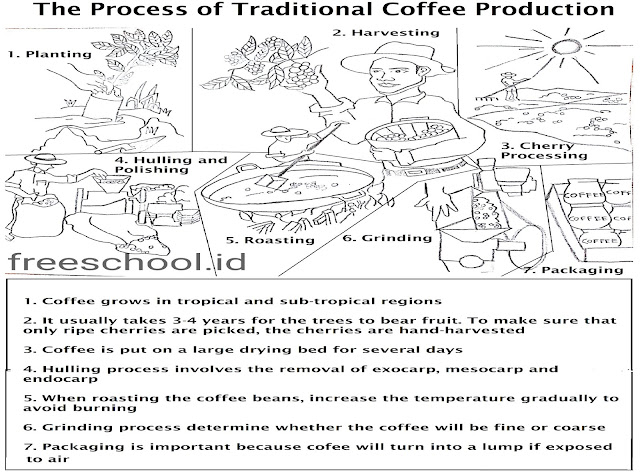Today, we are going to discuss how a process should be explained in IELTS Writing Task 1. Just like the map that we have previously discussed (see our previous discussion by following this link), a process requires different types of explanation. We may not deal with figures or trend but instead, we have to describe how certain thing is done (for example, how caterpillar turns into a butterfly), how certain things is made (for example, how to make a pancake), or how certain thing happens (for example, hydrological cycle), et cetera. In high school, most of us have learned how to write a procedure text, which is pretty much similar to process in IELTS Writing Task 1. Take a look at a sample diagram below.
 |
IELTS Writing Task 1 - Process |
The first thing that we have to focus on when describing a process is the structure of the writing. Remember that there's no trend in a process, everything has to be explained in order. For example, the picture above shows seven stages of traditional coffee production and so, the structure of the writing will most likely be like this:
- Introduction
- Explaining variables
- Giving detailed information of stage 1, 2 and 3 (what happens or what needs to be done in each stage, how it is done, what tools are used, how long does it take for the process to complete, etc.)
- Giving detailed information of stage 4, 5, 6 and 7 (what happens or what needs to be done in each stage, how it is done, what tools are used, how long does it take for the process to complete, etc.)
- The process of traditional coffee production
- The diagram illustrates how coffee is produced traditionally
- The process of traditional coffee production begins when...
- After three until four years, the trees will...
- The harvesting process is then followed by cherry processing...
- ...and so on and so forth.
Do you notice that I tried to explain the reason why the coffee is going through a packaging process? The picture says nothing about spoilage, aroma or taste of the coffee, but I explained it anyway because I can't think of any other reason why packaging process is included in the picture. I did the same thing when explaining the hulling stage, a stage where the dried outer skin of the cherries are peeled out to get the coffee beans, and how the mesocarp and sliver are also removed. This is not depicted in the picture (not in such detail that I don't have to try understanding why hulling stage is there in the first place), but we know that what we know as 'coffee' is actually the beans and not the fruit (though they are not actually beans either, at least by definition. More like seeds, I suppose). The entire writing will look like this:
The diagram illustrates how coffee is produced traditionally . The process consists of several stages which require human labor and tools.
The process of traditional coffee production begins when the coffee is planted. Coffee is usually planted It takes 3 until 4 years until the trees bear fruit. After that, farmers will start harvesting. Coffee cherries that ripen have dark red color. In traditional coffee production, only the ripen cherries are selectively picked. So farmers have to wait until the green cherry ripen before harvesting them. In traditional coffee production, the cherry-picking is usually a labor-intensive process. After being harvested, the cherries are then dried under the sun to remove the moisture. They need to be raked and turned to make sure that they are dried evenly.
The next process is hulling, in which the outer skin, also known as exocarp, will be removed using a hulling machine. Then, the beans are processed again to remove the mesocarp and endocarp. These are done manually. The coffee beans are then roasted in a very large pan and raked. After that, the roasted coffee beans are ground using a grinding machine. The traditional coffee production usually uses grinding machine powered by a diesel, although some people may also ground coffee beans by mortar and pestle, burr grinder, or any other tools that are operated by hands. After going through all the process, the coffee is ready for packaging. The packaging is very important to maintain the flavor and aroma as well as avoiding spoilage.

No comments:
Post a Comment